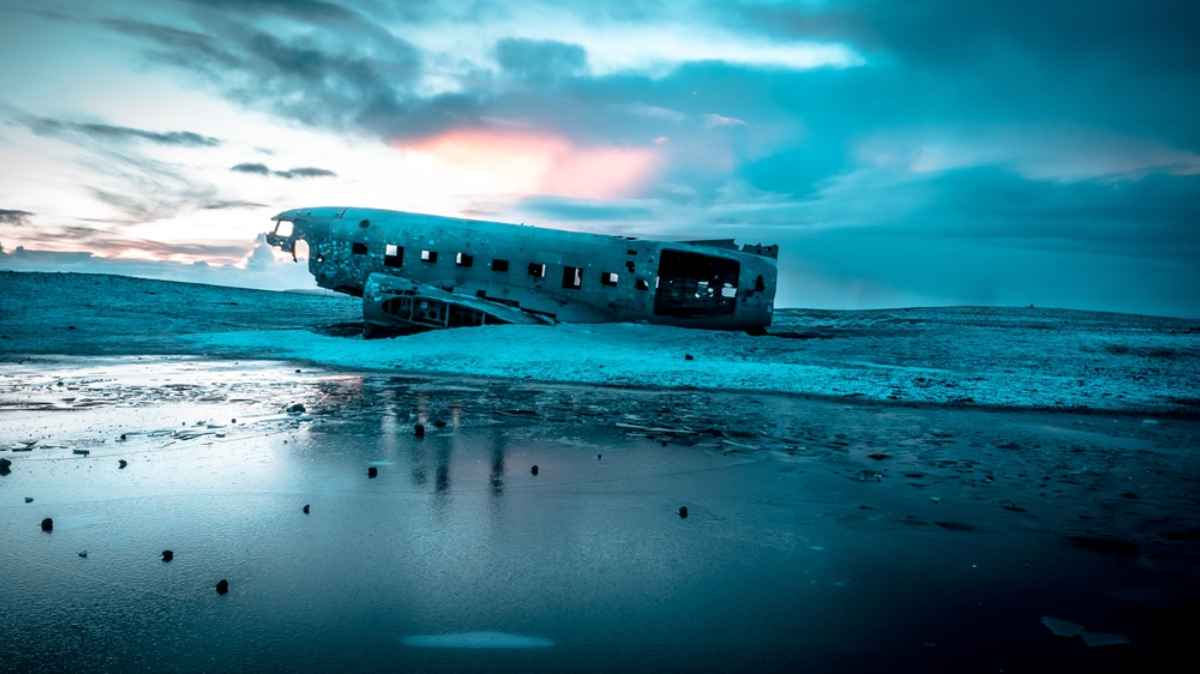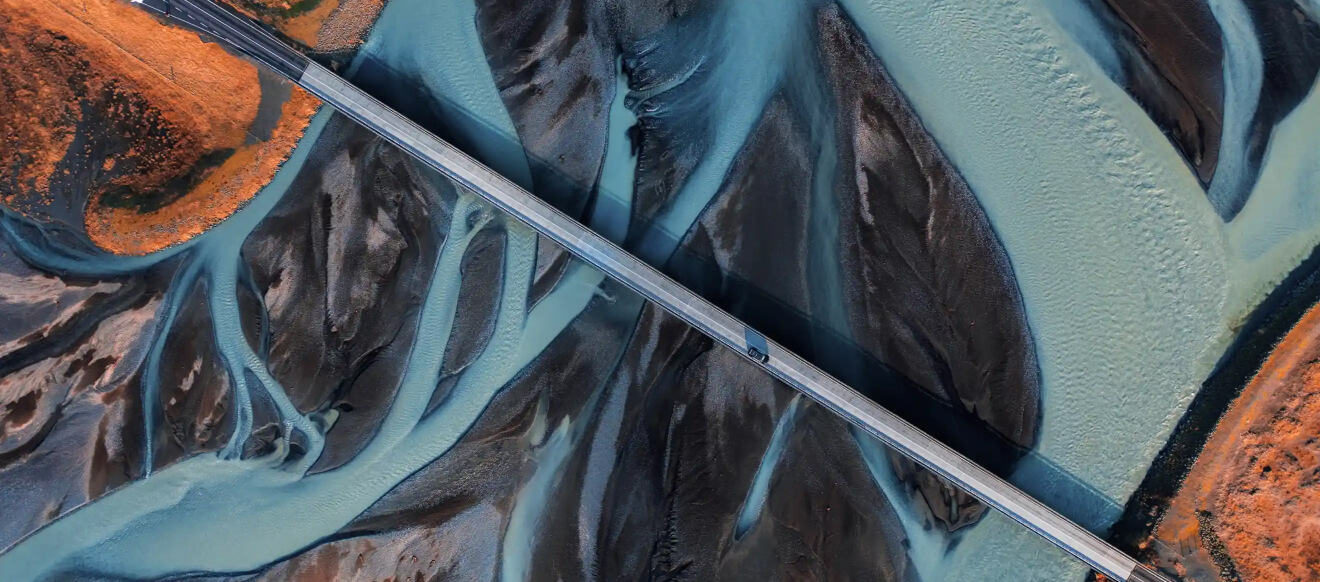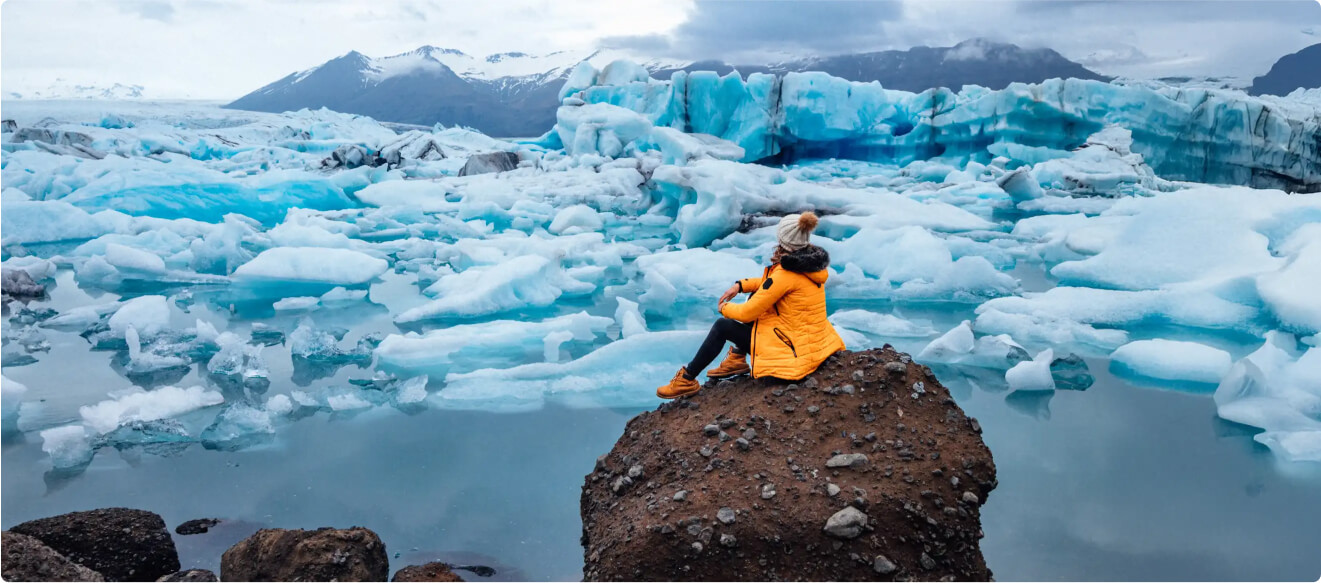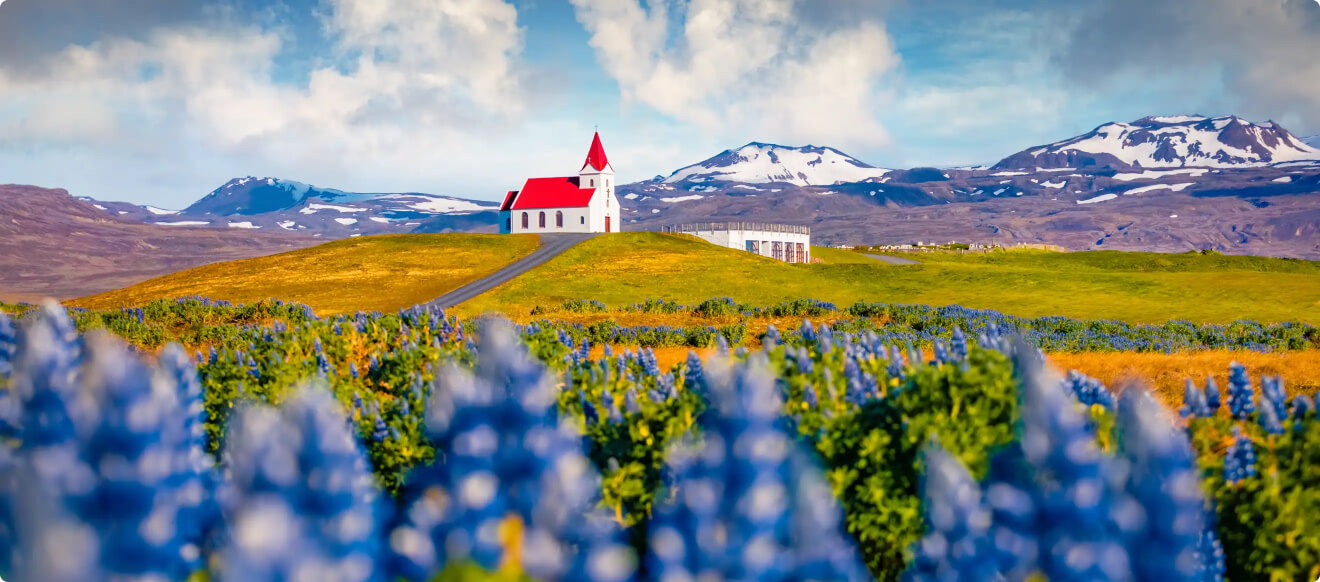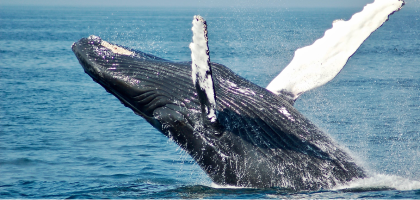Since 1973, an abandoned US Navy aircraft has lain on the southern shores of Iceland, after the plane crash-landed onto the black volcanic sand at Solheimasandur. Miraculously, all passengers on the DC-3 plane survived. The plane was returning to the naval air base at Keflavik after its supply mission to Hofn Hornafjördur Airport, delivering supplies for a radar station in Stokksnes.
While the cause of this Iceland plane crash is still debated, icing of the engines due to freezing weather conditions is listed as a highly likely cause, as is pilot error during fuel tank switching. After the crash, the US Navy salvaged all remaining useful parts from the aircraft, leaving only the shell of the DC-3 plane.
The Mystique beach of Sólheimasandur
Sólheimasandur Beach isn't just any black sand beach—it's part of a dramatic glacial outwash plain. This vast, eerie landscape was forged by powerful glacial floods, known as Jökulhlaup, that occur when eruptions beneath the Mýrdalsjökull glacier send torrents of meltwater rushing toward the sea.
These floods are among the most hazardous aspects of Icelandic volcanic activity, historically claiming more lives than lava flows. Stretching from Vík í Mýrdal to Kirkjubæjarklaustur, Sólheimasandur remains uninhabited due to this persistent flood risk, particularly from the Katla volcano beneath Mýrdalsjökull—one of Iceland's most active and unpredictable volcanoes.
Despite, or perhaps because of, its wild and untamed nature, Sólheimasandur is renowned for its hauntingly beautiful, almost lunar landscape. On clear days, the stark black sands are beautifully contrasted by vistas of the imposing Mýrdalsjökull glacier, Vatnajökull, and the rugged Highlands, making it a sight to behold.
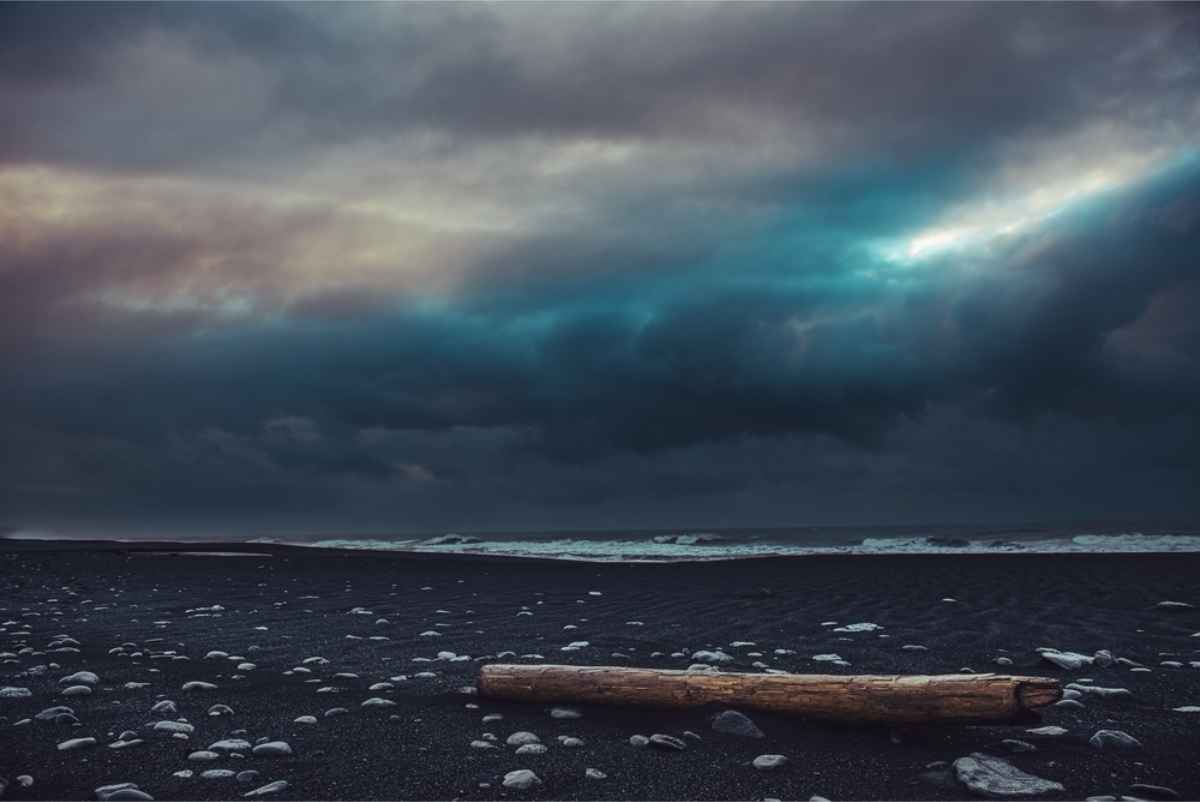
Local Legends and Myths
Sólheimasandur is more than just a visually captivating landscape; it's steeped in Icelandic folklore and legend. One of the most enchanting tales involves the Hidden People or huldufólk. These mystical beings, similar to Icelandic elves, are believed to inhabit Iceland's rugged terrains, especially rocks and hills.
Many locals claim that Sólheimasandur is a home to huldufólk, and there are numerous accounts of encounters with these elusive entities. They are known to either assist or play tricks on humans, their intentions often remaining a mystery. Adding to the area's eerie allure is the haunted plane wreck. The DC-3 wreckage on Sólheimasandur has inspired countless ghost stories. Some believe that the spirits of the surviving crew still linger around the site.
Visitors often report uncanny feelings, hear strange noises, and even claim to see ghostly apparitions, particularly during the long, dark winters. Local folklore also speaks of trolls, gigantic human-like creatures prevalent in South Icelandic myths. Legends assert that these trolls turn to stone when exposed to sunlight, and some say that the peculiar rock formations around Sólheimasandur are petrified trolls.
The Fascinating History of the DC-3 Plane Wreck
The Solheimasandur plane wreck has a tragic and mysterious history that still captivates visitors today. Let's delve into the story behind this iconic site.
The 1973 Crash Landing
The Sólheimasandur plane crash involves a Douglas C-117D US Navy plane that tragically crash-landed on the black sands of Sólheimasandur on November 21, 1973. The plane was on a mission, transporting crucial supplies to an American Army station near Höfn.
Mid-journey, the plane ran out of fuel, forcing an emergency landing. This nerve-wracking situation arose because the pilot accidentally used the incorrect fuel tank. Miraculously, all five crew members aboard the plane survived the ordeal unscathed.
The US military promptly salvaged what they could, but the remaining 10,000-pound shell of the aircraft was left behind on the beach, turning it into the iconic site we see today.
The Aftermath and Abandonment
So why was the Solheimasandur plane wreck left at the site? It's a mix of practicality and unique Icelandic charm. There was an understanding that if an American plane crashed in Iceland, the US would cover 85 percent of the recovery cost.
However, the Icelandic government would only move the wreck if a landowner filed a claim—which rarely happened. This is partly because Iceland is 80 percent uninhabited and has a harsh climate. Locals are resourceful and tend not to waste anything usable, so the wreckage was eventually stripped and repurposed into fences, roofs, and other structures. Think of it as upcycling!
The Solheimasandur plane wreck in popular culture
You may have seen the famous Iceland DC-3 plane wreckage on your screens before, such as in Justin Bieber’s 2015 “I’ll Show You” music video. Sigur Rós’ 2007 musical documentary, Heima, which follows the post-rock band around various venues in Iceland, also features the Solheimasandur plane wreck.
Where is the Iceland airplane crash site?
Located just over 6 kilometers (4 miles) from the Ring Road, also known as Route 1, the DC-3 plane wreckage in Iceland is fairly easy to visit from Reykjavík, taking around a 2-hour 15-minute drive. Solheimasandur is situated on the south coast of Iceland, around 24 kilometers (15 miles) from the closest town, Vik, in the west.
Skogafoss waterfall is around 10 kilometers (6 miles) to the east from the plane wreckage, taking around a 10-minute drive to reach. You may wish to plan your stop at Solheimasandur as part of a south coast tour by following the lighthouse trail along the coastline.
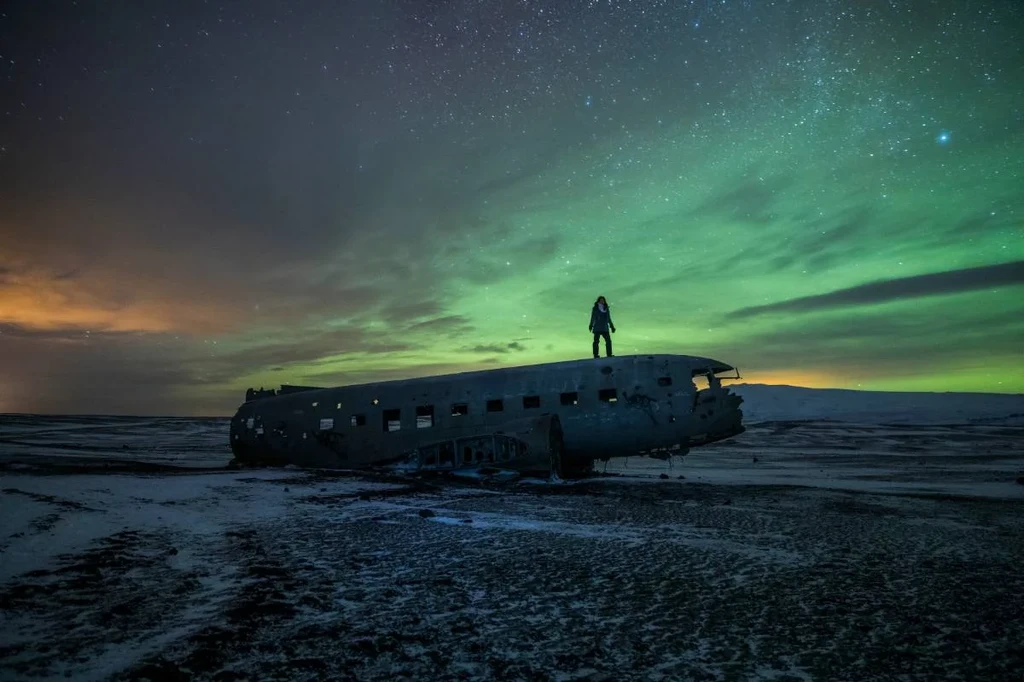
How to get to the Iceland airplane crash site
The majority of the journey to reach Solheimasandur is via the Ring Road, which can be easily driven by car. However, it’s no longer possible to drive directly to the site of the Iceland airplane crash yourself. This is due to the increasing number of visitors, difficult driving conditions on the volcanic beaches to reach the plane, and the damage done to the area’s delicate flora by vehicles. Instead, you can park in a specially created car park just off Route 1, around 3 kilometers (2 miles) from the plane crash site.
It doesn’t take long to hike to the DC-3 plane wreckage; from the car park, it’s around a 45-minute to 1-hour walk to the crash site, depending on your walking speed. The route will take you across a sparse desert environment, with views of green mountains and yellow markers along the way to guide you. Be careful not to make the journey when weather conditions are bad during the winter months.
If you don’t fancy walking, you can cycle along the same route to the plane for a quicker alternative that still allows you to enjoy the view and fresh air. You’ll need a suitable bike with thick tires to traverse the rocky path. During the summer months, you may find bikes to rent in the car park, although this isn’t guaranteed. There is also a Plane Wreck shuttle bus operating along the path to the Solheimasandur plane wreckage, usually running most days and taking around 15 minutes each way.
GPS Coordinates and Parking Tips
There's now a newly made parking lot right by the road, ensuring safe parking for all visitors. Previously, folks would park haphazardly on the side of the highway, leading to some pretty dicey situations. Given the site's popularity, you'll still find plenty of cars here regularly. Make sure to use the exact coordinates—63 27.546-19 21.887—and refer to this map available for your convenience.
Preparing for the Walk to the Plane Wreck
Now that you're almost there, let's go over some critical things to consider before heading out.
Distance and Duration
The hike to the plane wreck is approximately 4 km (2.5 miles) one way, making it an 8 km (5 mile) round trip. On average, it takes about 45-60 minutes to walk each way, depending on your pace and the weather conditions. The trail is relatively flat and straightforward, but keep in mind that it passes through an exposed, often windy landscape with little in the way of landmarks or shelter.
Accessibility
Reaching the plane wreck at Sólheimasandur can pose significant challenges for individuals with mobility impairments. The 4 km (2.5 miles) one-way hike traverses flat but exposed terrain, often buffeted by strong winds with little to no shelter along the route.
Unfortunately, the path is not wheelchair accessible, and the coarse, volcanic sand can make walking difficult, even for those without mobility issues. While private tours are available, many of them, such as the ATV tours, still require a moderate level of physical ability.
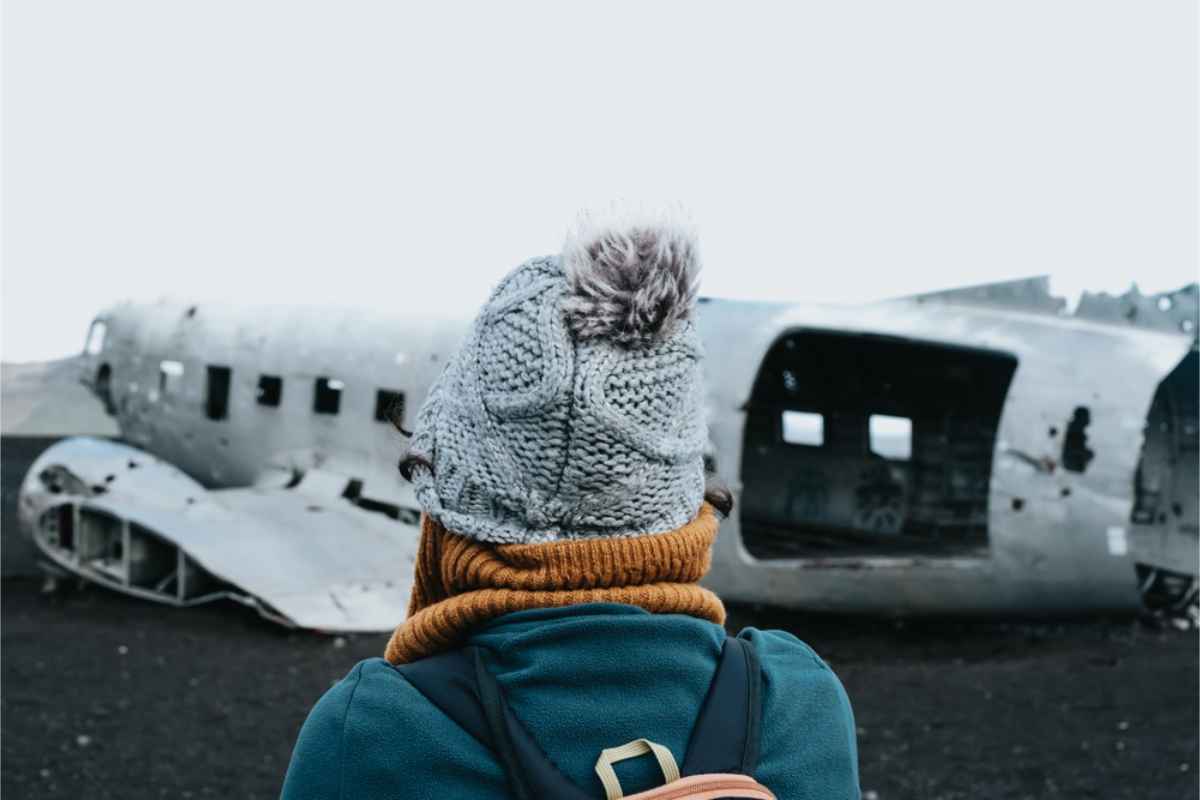
When to visit the DC-3 plane wreckage?
The Solheimasandur plane wreck is open all year round to visit. Still, due to the more favorable weather conditions, the safest time to go is during the summer in Iceland, from May to August. You’ll also benefit from longer daylight hours during these months, making your trip easier and more convenient.
Seasonal considerations
Weather conditions at Solheimasandur have been known to become bitterly cold during winter, with people even dying at the site of the plane wreck due to the harsh weather. The area around the DC-3 plane wreck is often quite empty, so make sure to bring your phone with you in case of an emergency. Try to plan your trip on a day with mild weather to make sure you can enjoy your visit.
Spring (April to June)
Spring in Iceland brings longer days and milder temperatures, making it an excellent time for a visit. The landscape begins to come alive, and though it's not as green as summer, the thawing snows create dramatic contrasts and vivid photography opportunities.
Summer (July to September)
Summer in Iceland is undoubtedly the best season for pleasant weather and accessibility. The midnight sun ensures nearly 24 hours of daylight, giving you ample time to explore and photograph the wreck at different times. Mornings and late evenings can offer beautifully soft lighting for photography.
Fall (October to November)
Fall in Iceland paints the landscape in rich hues of gold and red. While the days get shorter, the crowds start to thin out, providing a more peaceful experience. Late afternoon visits benefit from the golden hour's enchanting light, although weather conditions can become more unpredictable.
Winter (December to March)
Winter in Iceland adds a touch of magic and mystery to the wreck, often dusting it with snow. While conditions can be harsh, the short daylight hours give you a better chance to witness the Northern Lights dancing over the plane's silhouette. However, the snow and ice can make the terrain more challenging to navigate, and tours may be canceled due to weather.
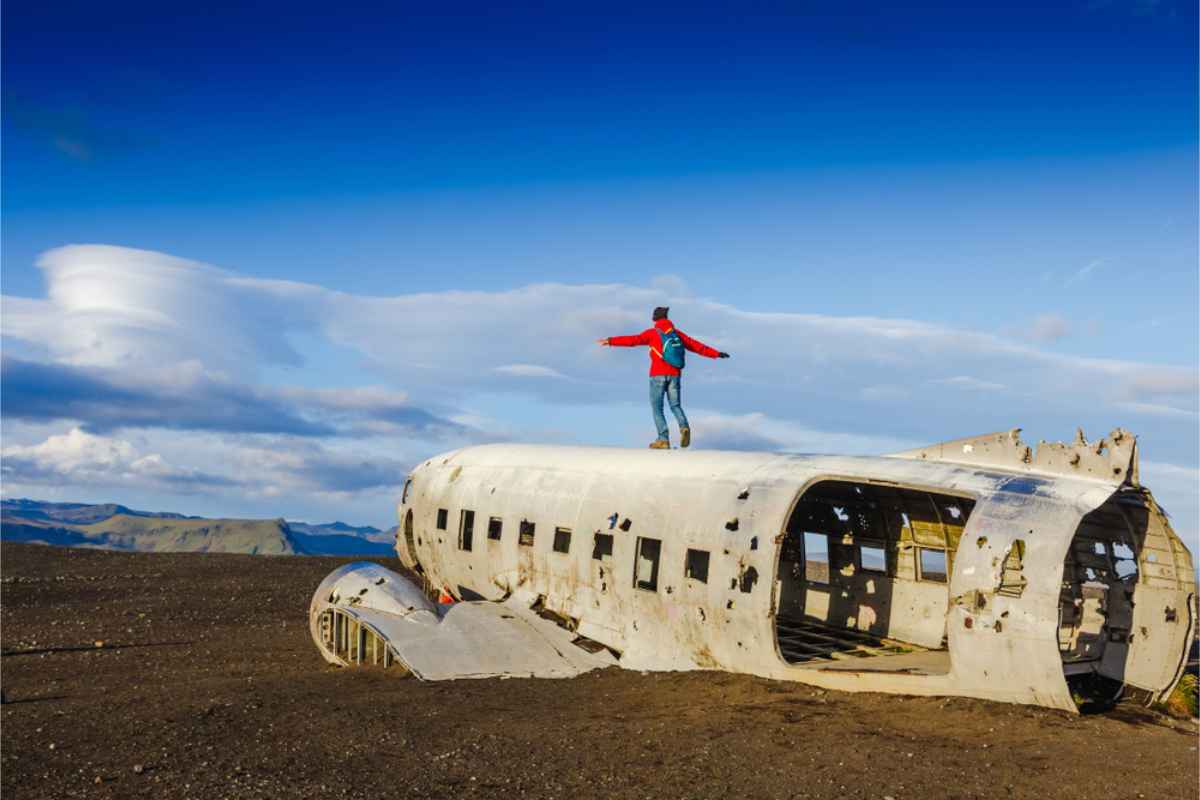
Solheimasandur plane wreck tours
Shuttle bus tours to the Solheimasandur plane wreck are available, as well as package tours that take you around Iceland’s magnificent south coast, including a stop off at Solheimasandur.
If you’d like to travel by bus to see the plane wreckage, you can book your shuttle bus tickets online in advance, ready to take the bus when you arrive at the dedicated Solheimasandur parking.
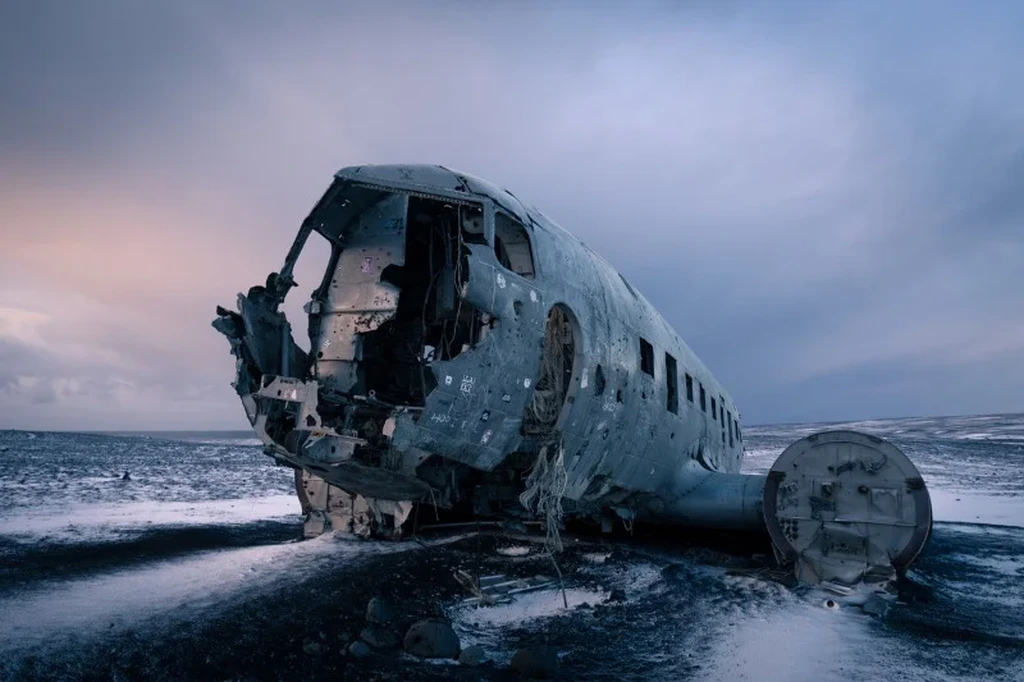
Top tips for visiting the Iceland DC3 plane wreck
-
We recommend wrapping up warm for your trip to the Iceland DC-3 plane wreckage, with layers coming in particularly handy. If you decide to walk from the car park, you may wish to remove your outer layer while on the trail. It can get cold quickly, so it’s a good idea to have a coat with you to add to your outfit. Wear some comfortable and waterproof layers, along with good walking shoes.
-
Seeing the northern lights at Solheimasandur plane wreck is a spectacular experience, with the colorful glow lighting up the sky above the skeleton of the airplane. The peak season to view the northern lights in Iceland is between September and March. Early autumn or late spring can be a good time to visit the plane wreck at Solheimasandur, when the weather isn’t too harsh and you have a good chance to spot the northern lights!
-
It’s free to visit the Iceland airplane crash site, although you’ll have to pay for parking, which can be bought online or via the Parka app.
Get prepared for your trip to Solheimasandur by reserving your car hire in Iceland ready for the trip of a lifetime in Iceland.
What to Expect at the DC-3 Plane Wreck
When you finally arrive at the site of the Sólheimasandur plane crash, get ready to be awed. The wreckage of the abandoned DC-3 sits starkly against the black sand, creating a jaw-dropping photo op that's straight out of a sci-fi movie.
Exploring the site, you'll notice the eerie yet captivating beauty of the twisted metal, with Iceland's powerful nature as the backdrop. Feel free to wander around and even step inside the plane for a closer look. Just be mindful of your surroundings and remember to respect this iconic piece of history.
Photography Tips
The DC-3 plane wreck is a must-see spectacle, and while no lives were lost in the crash, it's captured the imaginations of photographers and travelers alike. Remember, nature is ever-changing and slowly reclaiming this relic, so seize the moment. To take the best photos of the plane, here are some tips:
- Best Times to Visit: Early morning or late afternoon for softer, dramatic lighting.
- Angles to Capture: Shots from the front and side showcase the plane's eerie presence.
- Lighting Conditions: Overcast skies can create a moody atmosphere, while a clear day offers stark contrasts.
- Long Exposure: If you're into long exposure shots, consider capturing the movement of clouds across the sky or the waves if you venture to the nearby coast.
- People in the Frame: Including yourself or fellow travelers in the shots can provide a sense of scale against the vast landscape.
- Close-Ups: Don't forget to take close-up shots of the aircraft's details, such as the fuselage, windows, and interior.
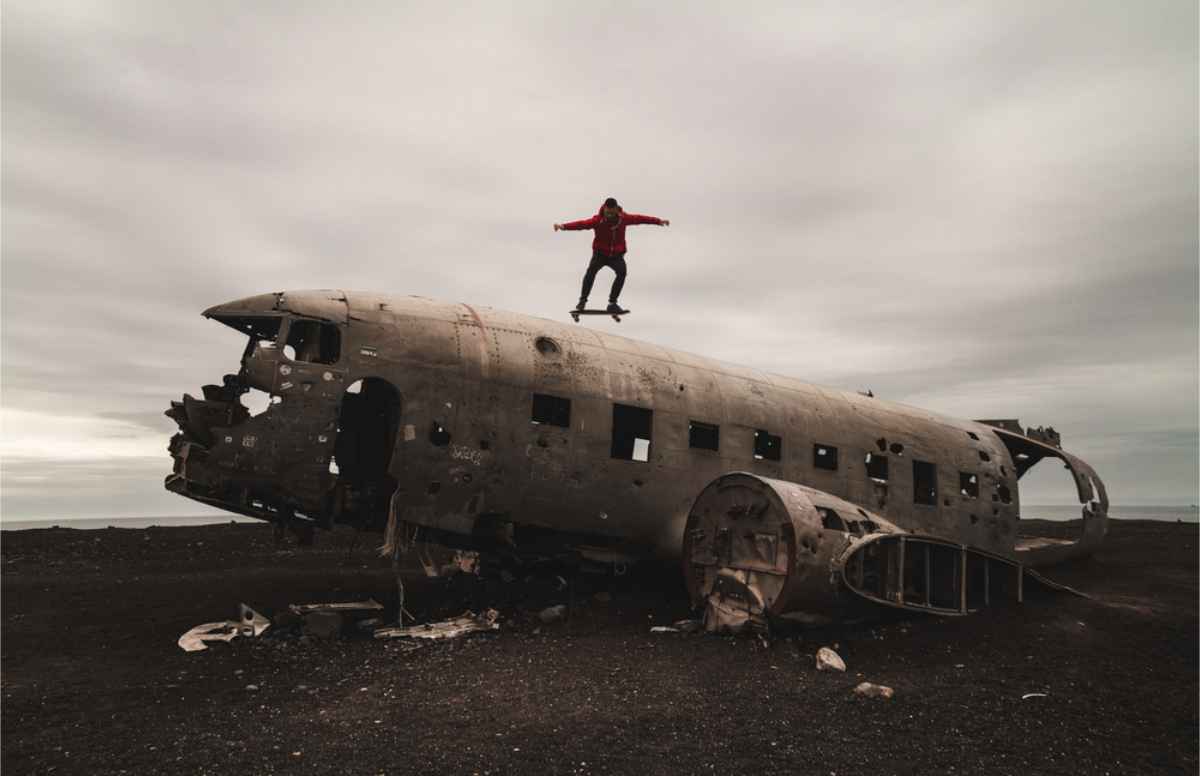
Top Things To and Nearby Attractions
You've reached the end of your adventure to the DC-3 crash site, but that doesn't mean the exploration has to stop there. Here are some other notable sights to explore in this stunning and diverse region:
- Reynisfjara Black Sand Beach: Just a short drive away from Sólheimasandur is one of Iceland's most famous beaches, with its striking black sand, basalt columns, and towering cliffs.
- Dyrhólaey Arch: Located at the southernmost tip of Iceland, this iconic arch offers stunning views of the rugged coastline and dramatic cliffs.
- Skógafoss Waterfall: One of Iceland's largest waterfalls, Skógafoss is a must-see with its powerful cascades and beautiful rainbows on sunny days.
- Sólheimajökull Glacier: For the more adventurous, a guided glacier hike and ice-climbing tour on this stunning glacier is an unforgettable experience.
Local Services and Amenities
When planning your visit to Sólheimasandur, consider the following nearby services and amenities to make your trip more comfortable and enjoyable:
Food Options
- Restaurant Hotel Anna: Located about a 25-minute drive from the parking area, offering traditional Icelandic cuisine.
- The Soup Company: Situated in Vík, around 20 minutes away, serving delicious soups and sandwiches.
- Smiðjan Brugghús: Also in Vík, this brewery and restaurant offer a variety of craft beers and hearty meals.
Restrooms
There are no restrooms at the Sólheimasandur parking area or along the way to the plane wreck. Make sure to use facilities in nearby towns before embarking on your hike.
Accommodation Options
- Hotel Skógafoss: Conveniently located near Skógafoss, offering comfortable rooms with easy access to nearby attractions.
- Hotel Vík: A modern hotel with scenic views in Vík featuring comfortable lodging and excellent amenities.
- Hótel Dyrhólaey: Positioned between Vík and the Sólheimasandur area, ideal for travelers seeking a peaceful retreat.
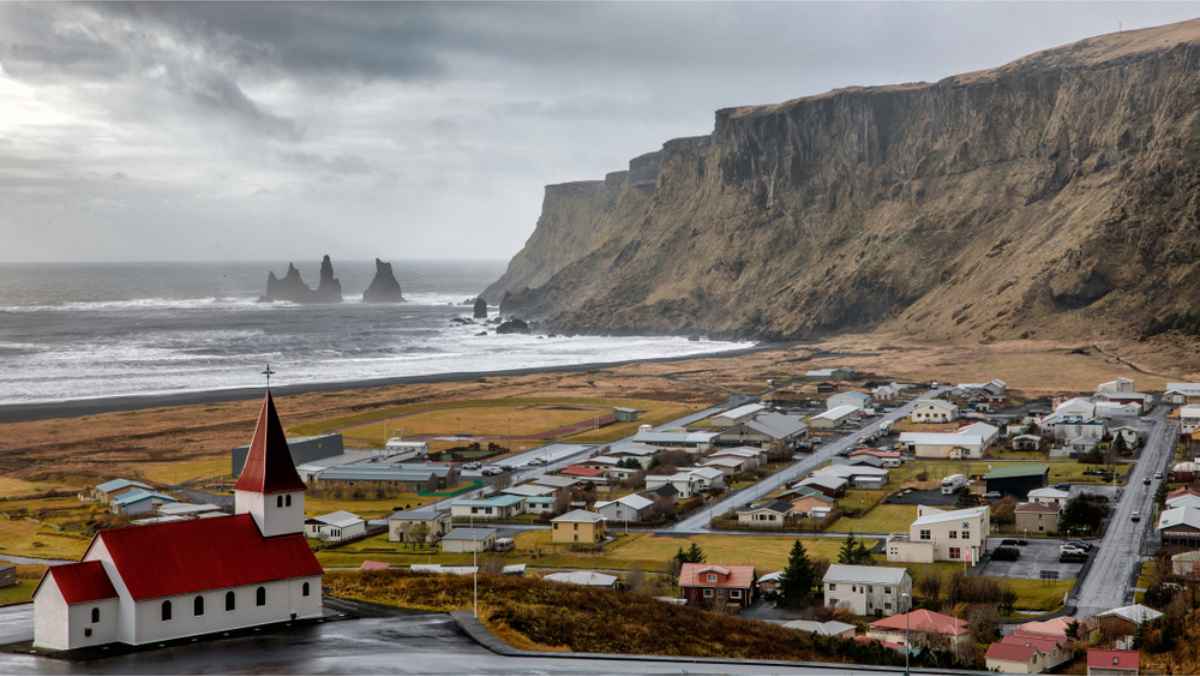
Environmental Impact and Conservation
The stunning landscapes of Sólheimasandur, including the iconic plane wreck, are fragile and sensitive to human impact. Authorities and local communities have taken several measures to preserve the natural environment and ensure it remains unspoiled for future generations.
These measures include establishing designated walking paths to minimize soil erosion, restricting vehicle access to prevent damage to the delicate sand and plant life, and posting informative signs to educate visitors on responsible tourism practices.
The Importance of Responsible Tourism
Responsible tourism is crucial in maintaining the pristine beauty of Sólheimasandur and its surroundings. When visitors practice sustainable travel habits, they help protect the natural environment and support local conservation efforts. This means adhering to marked paths, disposing of waste properly, and respecting wildlife and natural features.
How Visitors Can Minimize Their Impact
Visitors can minimize their environmental impact by taking several key actions. Here are a few simple ways you can help preserve Sólheimasandur's natural beauty:
- Stick to designated paths and avoid trampling on delicate plant life
- Dispose of any waste properly, including cigarette butts
- Respect posted signs and regulations
- Leave no trace - take all your belongings with you when you leave
- Avoid disturbing wildlife and be mindful of nesting areas
Making the Most of Your Visit to Sólheimasandur
Exploring Sólheimasandur and the South Coast of Iceland promises a thrilling adventure filled with breathtaking landscapes and unique experiences. Whether you're marveling at the DC-3 plane wreck, hiking glaciers, or capturing the beauty of Skógafoss Waterfall, each season offers its charm.
Remember to pack accordingly for the weather and make the most of the area's year-round splendor. With the essential tips and information provided, you're all set to embark on an unforgettable Icelandic journey. Happy travels!




